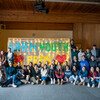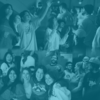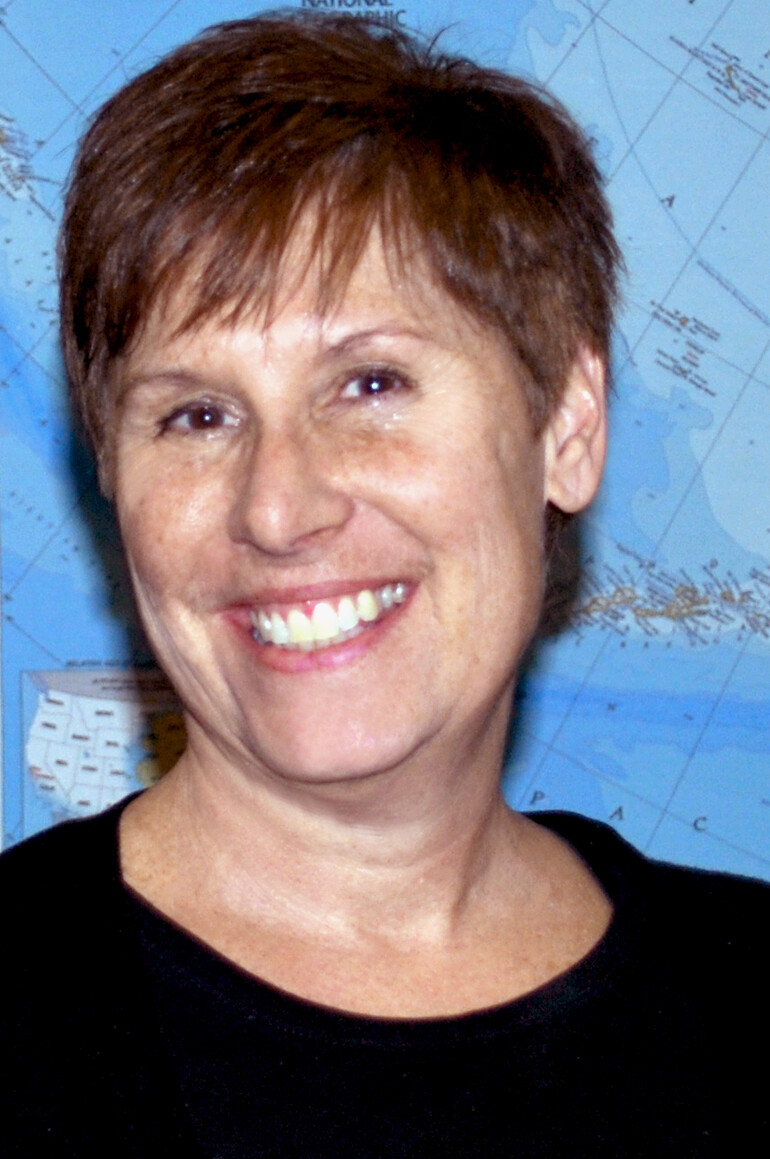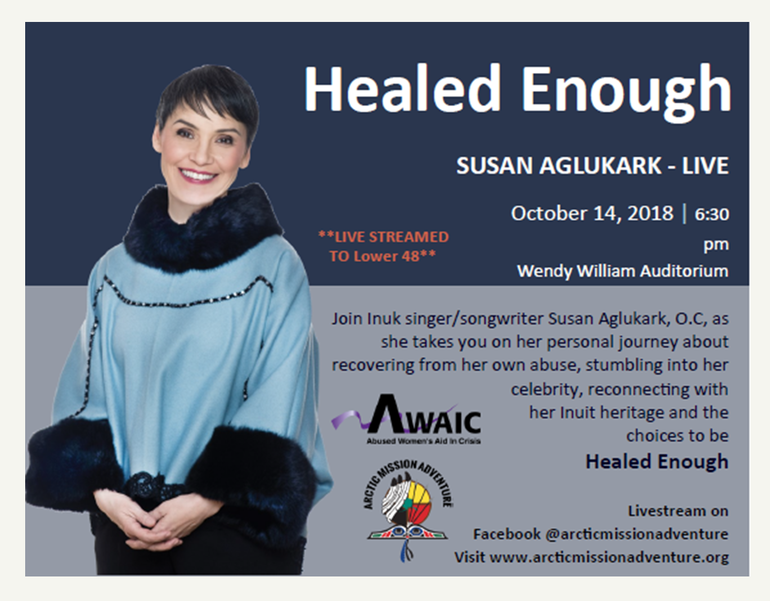EDITOR'S NOTE: Alaska has a sexual assault rate 3 times the national average and a child sex assault rate 6 times the national average. Arctic Mission Adventure is sponsoring a special program on Oct. 14, 2018, with Susan Aglukark, Inuk singer/songwriter, about her journey of recovery from abuse. The program will be livestreamed at 6:30 p.m. (AKDT) and 7:30 p.m. (PDT) on the Arctic Mission Adventure Facebook page.
In the short interview that follows, Steve Huey, North Pacific Union Conference Native ministries director, discusses sexual abuse in Alaska with Tandi Perkins, Alaska Conference director of development.
HUEY: I understand that sexual abuse in Alaska is a major problem. How did you learn first-hand of what women face in this area?
PERKINS: Steve, the best way to answer this is to share a story I heard when traveling around Alaska. One night Mary (a pseudonym), 13 years-of-age, was fast asleep at her family’s fish camp, downriver from a tiny village northwest of Fairbanks while a group of adults drank and caroused in the next room. She awoke to someone tugging down her pants, reaching between her legs. She struggled and kicked, and he lumbered out of the room. Mary says she’s been grabbed, chased, followed and molested so much in her short life that she’s now made it a habit to lock the bedroom door at night and shove a chair under the knob so no one can come in. She’ll wait up, trembling, until everyone at a party is passed out before she can comfortably fall asleep. She’s learned to avoid being alone with friends’ dads, or with grandpas at village potlatches, or with boys at basketball games, who’ve repeatedly groped her. “It’s just random, like, you’ll think everything’s all normal and then you’ll feel something on your backside,” she says. “You just freeze.”
HUEY: Share with us how pervasive sexual assault is in Alaska, particularly within the Alaska Native community.
PERKINS: A report from the Alaska Department of Public Safety says that 54 percent of Alaska’s sexual assault victims are Alaska Native, making Alaska Native women almost 10 times more likely than other Alaskans to be victims. It should be noted that although these statistics are remarkable, they are likely conservative as most cases go unreported. Mary never reported the many instances of sexual abuse to her parents — she was afraid of what would happen. When she did tell one of her sisters, the response she received was a shrug and a comment: “It happened to all of us. Just leave it alone.”
HUEY: This is shocking! How does this happen?
PERKINS: It is very difficult to understand the complexities of sexual abuse in Alaska, particularly in bush Alaska. These villages are remote, with little to no police presence. There's also significant trauma across generations and a pattern of victims tragically becoming perpetrators themselves. There's widespread substance abuse. Finally, there is the continued trauma of colonialism, which has upended traditional subsistence lifestyles and disrupted norms in ways that have made this kind of sexual violence more likely to take place.
Based on stories I have heard while visiting some of the native villages, women who are sexually abused are strongly discouraged from naming their abuser. In one village, a young girl was brought into the frontier medical post by her family, for treatment. The forensic nurse on duty asked the girl to name her abuser. She remained silent and stoical. Simultaneous to the girl’s treatment, the village elders called the girl’s parents, demanding that the perpetrator not be named. In turn, the parents pressured the girl to stay silent. The question of silence is complex across America, but especially as it relates to villages in bush Alaska. Members of these villages rely heavily on collective subsistence hunting and fishing. These tasks are primarily carried out by the men in the villages and when big game (musk ox, whale, and bear) are bagged, the entire village benefits. If a known perpetrator is named, brought to justice, and jailed, the village loses a provider. Women and girls who name the abuser are often shunned and ostracized from village and family social circles. The effects of being sexually abused are manifested through many behavioral outcomes, including suicide, drug and alcohol abuse, obesity, mental instability and physical abuse towards others.
HUEY: What is Arctic Mission Adventure doing to help women in need?
PERKINS: Arctic Mission Adventure, or AMA, is a ministry outreach for bush Alaska. We have several volunteers in place, but I would like share how God led in having a prominent singer/songwriter help raise awareness on abuse. My role in AMA is director of development, and as such, I am tasked with promoting the program throughout Alaska, the North Pacific and across America, as well as raising funds to support this ministry. After traveling to the villages and repeatedly hearing stories of abuse, God put on my heart to use this to reach those that need to hear of His love. Susan Aglukark, a well-known singer and songwriter in Canada who has experienced sexual abuse, shares her story through song and spoken word on how she was able to survive and even thrive after such a harrowing experience. A born-again Christian, she places considerable emphasis on her spiritual foundation. She says: “I know for a fact that if it had not been for God in my life, I would not have been able to take on the changes that have occurred in the last three years of my life.” Long story short, in just a few weeks, we were able to secure Susan to perform the weekend before the Alaska Federation of Natives — the largest annual gathering of Native peoples in Alaska.
The next challenge was finding a venue. Anchorage is a relatively small town, and venues during this time are at a premium. People kept saying to me “Oh, you are going to have a really hard time finding a venue at this late date.” We prayed that God would open doors and He gave us the Wendy Williamson Auditorium on the campus of the University of Alaska. In truth, He also gave me a huge faith challenge because this auditorium seats 900 people! I have only been in Alaska and my position for six months. So, our challenge with trying to schedule an event of this magnitude is simply not having enough time to get the word out to the community and across Alaska. We haven't really had enough time to fundraise and gain sponsorship, or sell tickets to fill 900 seats! But we serve an awesome God! In the last few weeks, doors have opened. We are moving forward in faith that we will be able to cover the cost of the event and sell tickets enough to fill the seats.
HUEY: What do you hope to come out of Susan’s performance?
PERKINS: AMA is a faith-based nonprofit with a mission to encourage, empower, and equip village communities through physical, emotional, spiritual, and mental support from resident volunteers. We have identified a need throughout Alaska to raise awareness of and advocacy against sexual abuse. We believe Susan’s story provides a spirit of hope and an example of how survivors of sexual abuse can heal enough. “Healed Enough” is a 60-minute speaking and singing presentation by Susan. During the performance, she sings and talks about re-connecting with her Inuit heritage, how the challenges in the early years of her career became the catalysts and how meeting these challenges became her healer.
There are a couple of key things that makes this outreach unique. One, we are striving to bring Susan’s story of hope to the people who really need to hear it. We are seeking sponsorships/donations to cover the attendance costs for survivors of sexual abuse who reside in the Anchorage and Mat-Su Valley areas and who can’t pay to see Susan. We are working with local shelters to identify these folks. We are also seeking support to livestream, via Facebook live, the performance to as many bush villages as robust internet connections will allow. As such, we have coordinated with workers in Bethel, Togiak, Nome, Selawik, Copper Valley, and others along with Lower 48 Native American communities to promote this night of solidarity and hope.
Finally, part of the proceeds from this event are designated to initiate a pilot program called “Safe Haven” in villages where AMA has workers. This program will partner with state and local programs for training and support that enables our workers to help someone in crisis. Safe Haven provides a temporary place to go, food to eat, and clothes if needed, to get out of a hostile environment and provide resources for longer term help. AMA currently has volunteer workers in Dillingham and Togiak and will reach out to those communities and individuals in need.
HUEY: How can we help with this wonderful event?
PERKINS: We are asking folks in the lower 48 to help us spread the word about this special event! We are inviting you to become an ambassador for the Arctic Mission Adventure event "Healed Enough" by hosting a viewing of the live event in your church and school. We are also seeking sponsors who can provide a free ticket to someone who cannot afford it. For example, $100 will sponsor five people to attend "Healed Enough." Finally, and most importantly, we are asking folks to pray for this event. We have never attempted something this big, and it will take God’s hand and blessing to reach those hurting from the trauma of sexual abuse.
HUEY: Where can folks go for more information and to support Healed Enough?
PERKINS: To learn more about Arctic Mission Adventure, go to www.arcticmissionadventure.com; click here to see a promotional clip for Healed Enough.
Support for Healed Enough can be in the form of check, online donation through www.arcticmissionadventure.com, or telephone. Please mark all gifts “Healed Enough.”
Arctic Mission Adventure, Healed Enough, 6100 O’Malley Rd., Anchorage, AK 99507; for more information, call 907-346-1004.
HEALED, Live Event Sunday night, Oct. 14, 2018 at 6:30 p.m. (AKDT) or 7:30 p.m. (PDT). Livestreamed on our Facebook page @arcticmissionadventure.
*Name has been changed.









